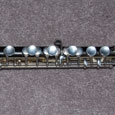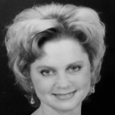The Anaheim Marriott Hotel was home for the 2010 National Flute Association Convention, and each day was filled with performances and lectures to enrich and educate flute and piccolo players alike. That said, it was a piccolo year at the convention with the Piccolo Artist Competition, Piccolo Master Class Competition, and many concerts devoted entirely to the instrument – too many to cover here.
One of the many highlights, however, was the Piccolo Gems concert that featured six piccolo solos accompanied by the California State University Fullerton Wind Symphony. Retired Army Band piccoloist Nan Rafael, sporting a festive Uncle Sam hat, processed onto the stage with two drummers and presented Dick Hyman’s flashy Piper Patriot of 76: Fantasia on Melodies of the Revolutionary War, arranged by Paul Murtha. This piece is characteristic of the Golden Age of piccolo music and is a fine patriotic piece, suitable for good high school players. It could be the centerpiece of a 4th of July concert.
Boston Symphony piccoloist Linda Toote then played the beautiful and difficult Fantasia on Irish Airs by Fred Lax. This is another excellent piece to feature the piccolo in band concerts from high school to professional community bands that perform mostly in the summer.
“Yankee Doodle” has been arranged for every instrument and is well known to band concert audiences. Lois Herbine chose one of the best versions, written by George Purdy in 1883. It is in the traditional form starting with an introduction followed by a theme and variations. A little known fact is that researchers can find no biographical information or listing of any other pieces Purdy might have written.
Royal Flemish Philharmonic piccolo soloist Peter Verhoyen left the audience breathless with Derek Bourgeois’ spectacular Piccolo Piccante. The composition is good, however the performance of Verhoyen is what sticks in the memory. His playing was flawless and subtle, with great dynamic variation, and wonderful intonation. He has produced three CDs of music that we have rarely heard. They are an outstanding guide for phrasing and musianship.
Sarah Jackson highlighted both strength and beauty in piccolo playing with Eugene Damare’s Les echos de bois; Fantaisie imitative, Op. 220. Unfortunately over the years about 80% of the parts have disappeared, leaving only the piano score, piccolo part, and clarinet and horn parts. Jackson had Randy Bass arrange the piece so we can all play it.
The concert ended with the Dean of Piccolo, Walfrid Kujala, performing Flash! Kujala convinced Daniel Dorff to make a band arrangement of his highly successful piece, and now young flutists can all show off technique in a band concert.
Piccolo Artist Competition
Six players made it to the semi-final round of the Piccolo Artist Competition: Mackenzie Danner, Anke Lauwers, Lindsay Leach, Izumi Miyahara, Jenny Robinson and Thomas James Wible. The winners were announced prior to the Saturday evening Gala Concerto Concert: Third Prize, Jenny Robinson; Second Prize, Thomas James Wible; and First Prize, Anke Lauwers. All prizes for this competition were underwritten by a gift from Keefe Piccolos.
The Piccolo in Flim
Known as the “Hollywood Flutist” for her more than 1,200 studio recordings for film and television, Louise DiTullio’s recital, entitled “All That Jazz,” was a gift to the convention lineup. She commissioned the final work, Ronald Royer’s Short Stories, for her CD the Hollywood Flute, which was released in 2010. Short Stories features the entire flute family – alto, bass, C flute, and piccolo – and displays the styles used in film music for these instruments.
She states, “To be a studio flutist means to be proficient in all four instruments, and since I always played a group of pieces featuring all four flutes in my recital programs with great success, these pieces seemed the perfect solution. Short Stories has elicited more response than any of the other pieces on the CD. Listeners enjoy the colors of the various instruments.
“Being able to read jazz and swing lines is also a necessity in the studios. I thought it would be fun to demonstrate that skill, although I do not claim by any stretch of the imagination to be a jazz flutist. I also wanted to show the piccolo as an instrument of beautiful tone since there is a general misconception that it is a squeaky-sounding instrument.”
Noteworthy Concerts
A recital titled “Music for Piccolo and Piano” showcased Nicole Esposito performing Katherine Hoover’s colorful Three Sketches, Lois Herbine playing Dorff’s Sonatine de Giverny and Mike Mower’s Sonata for Piccolo and Piano, and Verhoyen, who played Poulenc’s haunting Villanelle, Darius Milhaud’s Exercise Musical, and Robert Beaser’s Souvenirs. The Beaser showcases his love of American folk music and includes “Happy Face,” an original tune he wrote in Italy in 2001 when he was there to accept the Prix de Rome, “Lily Monroe,” “Cindy Redux,” “Spain,” which is based on Flamenco-like themes in the piano, and the haunting “Ground 0,” which remembers his native New York City.
On “Strange Bedfellows: Music for Flutes, Piccolo, and Unlikely Partners,” Jan Gippo joined pianist Lorna Eder and contrabassoonist Shawn Jones, who learned his massively difficult part in less than two weeks, in a performance of Stephen Hough’s epic work Was mit den Traenen geschiet.
Gippo writes, “Loosely translated the title means, Where do the tears go. Hough is a very serious composer and wanted to explore the timbre of each pairing, especially the extremes of the contrabassoon and piccolo. It is a difficult piece, both in the speed of notes with awkward patterns and in the sustained high-B naturals, at a pp dynamic. Adding to the difficulty is the ensemble of meters. The parts have quite a number of compound rhythms and many times none of the instruments are accenting the same grouping.
“The piece is in three movements with no pause between the first and second movements. The first movement takes a five-note motive and reworks it through all of its inversions, passing it along to each instrument. The second movement is a flurry of notes for everyone, with different meters and tempos, which has the effect of keeping the flow even, while the performers are busy lining up the tempos with the accents of the passage work. The third movement starts with the piccolo on a high B and sustaining it for four counts and pp, then moving very slowly down the scale. This is all in unison with the contra. The piccolo has a melody that is lyrical, and it is passed to the contra. The piece then ends quietly – the tears have gone away. This is an excellent piece, but hard to listen to. It is a great challenge and should be performed many times.”
The centerpiece of the convention for piccoloists was the world premier of Eric Ewazen’s beautiful On Wings of Song, a Concerto for Piccolo and Orchestra. This piece is beautiful and unabashedly tuneful, quoting Mendel-ssohn’s melody throughout. Ewazen has also arranged it for band, so high school students can perform excellent music with either orchestra or band. On Wings of Song is a piece that will be performed many times. After one hearing, every piccolo player will want to have a turn at playing these stunning melodies.
Open Piccolo Master Class
Los Angeles Philharmonic solo piccoloist Sarah Jackson conducted the Open Piccolo Master Class, a true highlight because of the interchanges between participants. After performances of Hoover’s Three Sketches, excerpts from Bartok’s Concerto for Orchestra, Beethoven’s 9th Symphony, and Tchaikovsky’s 4th Symphony played by Lauren Waidelich Stephanie Miller, and Kathy Marsh, Jackson addressed topics such as dynamic contrast, alternate forms of articulation, and the extreme importance of protecting your hearing with regular earplug usage. All in all, it was a great convention for piccolo enthusiasts.






